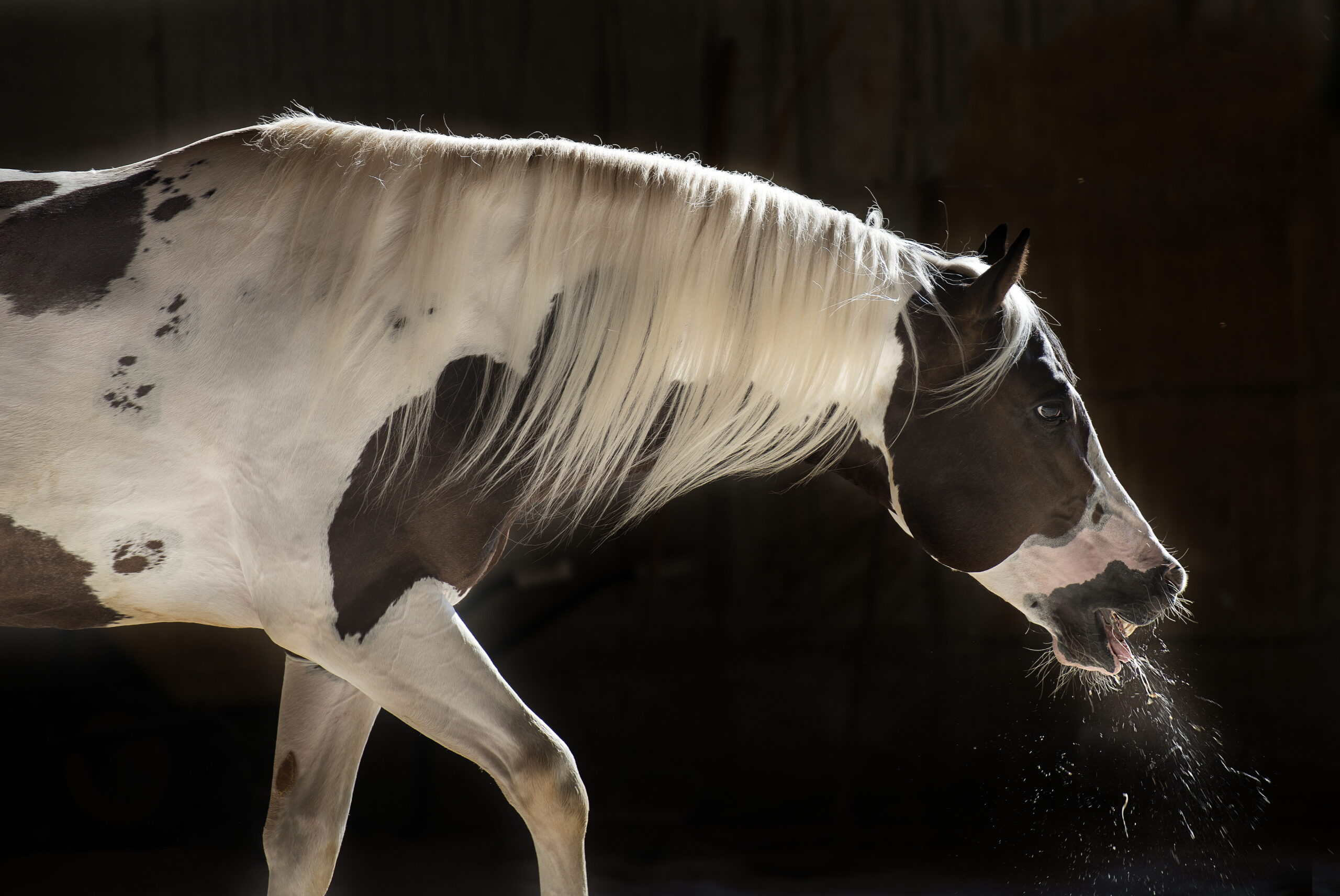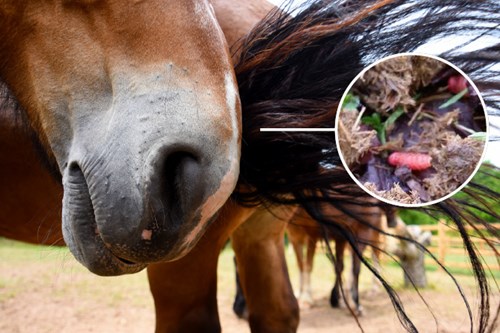Cough in Horses
A cough is a protective reflex to clear the airways. An occasional cough with dust or at the start of exercise can occur, but a persistent cough (more than a few episodes in a day or lasting beyond 24–48 hours), a cough with fever, nasal discharge, increased breathing rate or effort, poor appetite, or any cough in a foal warrants veterinary advice.

In the first hour
Confirm a rectal temperature (adult fever >101.5 °F / 38.6 °C; ≥104.0 °F / 40.0 °C is an emergency; any foal with fever or respiratory distress is urgent). Count resting breaths per minute and watch for labored breathing, flared nostrils, or abnormal noise. Note presence and character of any nasal discharge. Isolate from barnmates, move to fresh air, and reduce dust (damp hay or switch to low-dust forage). Do not exercise the horse. Provide fresh water. Avoid medications or nebulization unless your veterinarian directs you. Call your veterinarian promptly if fever, distress, or exposure risks are present, or if the cough persists beyond 24–48 hours.
What Counts as a Concerning Cough
An occasional cough with dust or at the start of exercise can occur. A cough is concerning if it’s persistent (>24–48 hours), frequent in a single day, or paired with fever, nasal discharge, or breathing effort—or if the patient is a foal.
Persistent or frequent
Coughing that continues beyond 24–48 hours, or many episodes in one day, deserves veterinary advice.
Cough with fever
Adult fever >101.5 °F (38.6 °C) raises concern for infection and requires prompt vet guidance.
Breathing effort or noise
Labored breathing, flared nostrils, heaving flanks, or abnormal noise (stridor/wheeze) need urgent assessment.
Nasal discharge
Thick, colored, foul-smelling, or bilateral discharge suggests respiratory disease—call your veterinarian.
After travel or new arrivals
Recent transport, shows, or new horses increase contagious risk (influenza, EHV, strangles).
Foals
Any persistent cough in a foal, especially with fever or poor nursing, is urgent and needs veterinary evaluation.
First-hour plan: owner-safe steps
01
Check temperature and breathing
Take a rectal temperature and count resting breaths for 60 seconds. Adult fever >101.5 °F (38.6 °C); normal resting RR ≈8–16/min.
02
Assess effort and discharge
Watch for flared nostrils, abdominal effort, noise (stridor), or thick/colored nasal discharge—these raise concern.
03
Isolate with biosecurity
Handle this horse last; separate buckets and tools; avoid nose-to-nose contact; wash hands and boots.
04
Improve air quality and reduce dust
Move to fresh air; dampen hay or use low-dust forage; avoid bedding changes that increase dust.
05
Rest and monitor
Do not ride or lunge. Recheck temperature and breathing every 2–4 hours; log times and findings.
06
Call your veterinarian
Same day if cough persists >24–48 h or with fever/nasal discharge; immediately for labored breathing, ≥104.0 °F (≥40.0 °C), or any foal in distress.
Red Flags for Horse Cough: When to Call or Trailer Now
These signs indicate an emergency or urgent evaluation. Follow your veterinarian’s instructions before trailering—some cases are safest to isolate on site.

Respiratory distress
Fast or labored breathing, nostril flare at rest, obvious abdominal effort, cyanotic or very pale gums.

Cough with fever
Adult temperature ≥104.0 °F (≥40.0 °C) is an emergency; any fever with cough in a foal is urgent.

Thick or bloody discharge
Thick, foul-smelling, or blood-tinged nasal discharge with cough needs immediate veterinary guidance.

Depression, not eating, or dehydration
Lethargy, poor appetite, reduced drinking/urination, or tacky gums alongside cough increase urgency.

Foal or late-term broodmare
Foals with cough (especially with fever or poor nursing) and late-term broodmares require urgent evaluation.

Outbreak risk or recent travel
Known barn cases, new arrivals, or recent shows/transport increase contagious disease risk—isolate strictly and call your vet.
Likely Causes of Horse Cough by Season & Context
These are common, owner-facing differentials to discuss with your veterinarian. Use them to guide isolation, dust reduction, and biosecurity while you seek medical advice—only a vet can diagnose.

Viral upper respiratory infection
Common with travel or new arrivals (e.g., equine influenza, EHV-4). Often fever, cough, and nasal discharge; more activity in cool seasons and crowded barns.

Strangles (Streptococcus equi)
Highly contagious; fever may precede cough, nasal discharge, and swollen lymph nodes. Strict isolation and separate water sources are essential.

Equine asthma (RAO/SEA)
Chronic, noninfectious airway inflammation triggered by dust/molds; cough, exercise intolerance, increased breathing effort. Improve ventilation and reduce dust while awaiting vet guidance.

Mild–moderate equine asthma (IAD)
Intermittent cough and poor performance without overt distress; often linked to airway irritants. Veterinary evaluation confirms and guides management.

Pneumonia / pleuropneumonia
Cough with fever, increased breathing, and depression; risk increases after long transport or a recent viral illness. Needs prompt veterinary care.

Lungworm (Dictyocaulus) in donkey-exposed herds
Cough may occur when horses co-graze with infected donkeys. Consider if there is donkey contact and pasture exposure; your vet can advise testing and control.
What to Tell Your Veterinarian
Provide clear, time-stamped facts. These details help your vet judge urgency, infectious risk, and next steps. Avoid medications or nebulization unless your vet directs you.
When it started, how often it occurs (episodes per day), and whether it’s worse with exercise, eating hay, or in the stall.
Exact rectal temperatures with times. Adult fever >101.5 °F (38.6 °C); ≥104.0 °F (≥40.0 °C) is an emergency.
Resting breaths per minute (normal adult ≈8–16/min) and any signs of labored breathing, flared nostrils, heave line, or noisy breathing.
Presence, color, thickness, and odor of discharge; appetite, drinking, energy level; any fever, lethargy, or exercise intolerance.
Recent shows or transport, new horses on the property, known cases in the barn (e.g., influenza, EHV, strangles), and shared water sources.
Hay type and dust control (soaking/steaming), bedding, ventilation, turnout vs. stall time, recent weather shifts, and any recent vaccines, dewormers, or antibiotics with dates.
Horse Cough FAQ: Fast Answers for Owners
When is a horse’s cough considered concerning?
If it persists beyond 24–48 hours, is frequent in a single day, or occurs with fever, nasal discharge, increased breathing effort, poor appetite, or in a foal—contact your veterinarian.
What is a normal resting breathing rate for adult horses?
About 8–16 breaths per minute at rest. Count for a full 60 seconds. Increased rate or obvious effort at rest is a red flag.
Is strangles ‘airborne’?
Strangles spreads mainly via close-range droplets and contaminated hands, tack, or water (fomites). It is not known for long-distance airborne spread. Strict isolation and hygiene are essential.
Could dust or moldy hay cause coughing?
Yes. Dust and molds can trigger equine asthma. Improve ventilation, reduce dust (dampen or steam hay, consider low-dust forage), and discuss management and diagnostics with your vet.
Should I exercise a coughing horse?
No. Rest the horse until your veterinarian advises otherwise. Exercise can worsen respiratory irritation or mask severity.
When is cough with fever an emergency?
At ≥104.0 °F (≥40.0 °C) in any horse, or any fever with cough in a foal, seek immediate veterinary guidance. Also urgent: labored breathing, blue/pale gums, or inability to tolerate lying down.
Useful links
Start with vitals and isolation basics. These references cover strangles biosecurity, sick-check cues, and vaccine context for respiratory disease.
